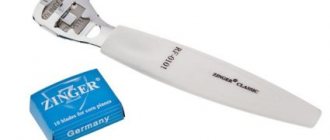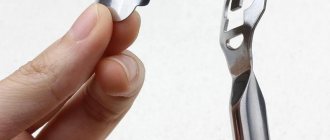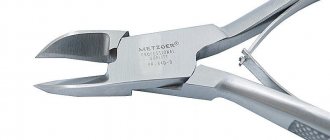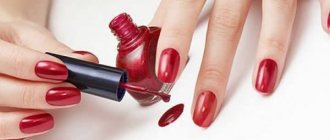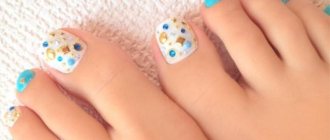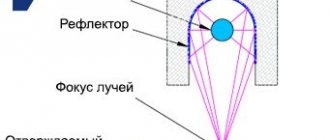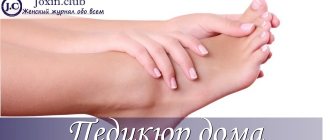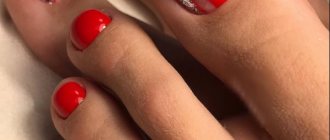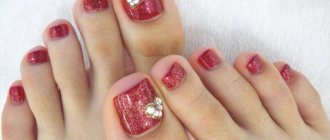Immortal classic
Classic trim pedicure has been used for foot skin care for more than a century. It is very easy to do at home, there is no need to purchase expensive equipment, all you need is a bowl, salt, soap, a razor with a disposable blade or a set of pumice stones, scissors and a nail file.
During the procedure, the legs are steamed in a warm bath with salt or soap, then they are cleaned of dead cells with a blade or pumice stone, cuticles and nails are cut off. Nails are treated with a nail file. The disadvantages of trimmed pedicure include:
- high risk of cutting yourself during manipulations to clean dead skin cells;
- the possibility of contracting a fungal or microbial infection;
- During the procedure, not only dead cells are cut off, but also living ones, this can accelerate the formation of rough areas.
Main types
Classic edged
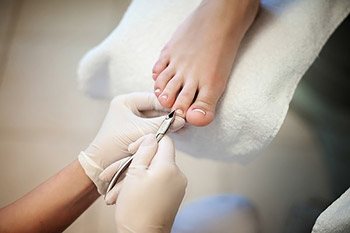
This is the most ancient type of pedicure, which is already more than 100 years old, so it has “overgrown” with its own characteristics. First, the feet are steamed in warm water with the addition of sea salt, herbs and soap. Then the nails and cuticles, soft after water, are trimmed with scissors, and the feet are cleaned with scraping devices .
This type is suitable for doing it yourself at home, but it is the most dangerous, since you can easily get hurt or cut with sharp instruments.
European unedged (dry)

This pedicure is considered a subtype of the classic one, but unlike it, it is done on dry feet. This does not mean at all that the client will experience discomfort during the procedures: all manipulations are painless and even pleasant.
The cuticle is not cut, but treated with a special substance that softens areas of the skin and slows down its growth. Then it is simply moved to the edge of the nail plate . The keratinized growths on the feet themselves are removed using softer means - scrapers or graters. This pedicure can also be done at home on your own, but to get rid of cuticles completely, you will need 8 to 10 regular treatments.
Japanese unedged
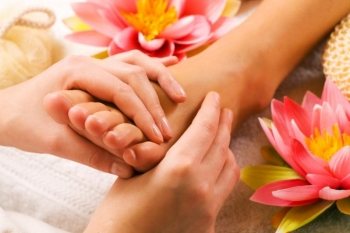
The legs are treated with an antibacterial agent, the cuticle is pushed back using a tachibana , and then it is lubricated with cucumber extract. Then it is softened with minerals, and a scrub is applied to the feet. Then the feet are immersed in aromatic baths.
The nails are buffed with a rice block until they have the perfect shape. To stop the cuticles from growing or to reduce the growth rate, they are treated with lotus oil . The legs are covered with beeswax powder , and the feet are smeared with a solution based on citrus essential oil . This helps rejuvenate and tone the skin on your feet. The final stage of the pedicure is a relaxing foot massage and medicinal herbal masks.
Fish pedicure
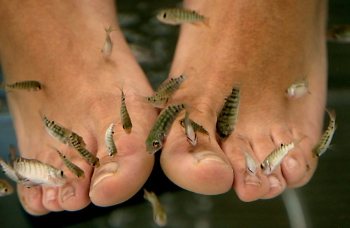
Pedicure as part of natural peeling. The client simply dips his feet into an aquarium where fish doctors of the Garra Rufa breed , feeding only on dead cells. With their mouths in the form of suction cups, the fish absorb all excess and keratinized areas of the skin , while delivering pleasant sensations to the client.
This is the best choice if you decide not only to take care of your feet, but also to rejuvenate them. Most often, this procedure can be seen in hot tourist countries right on the beach; the fish themselves come from Turkey, Japan or China. They are almost never full, so pedicurists can work almost without breaks. Such fish are not suitable for home breeding: without constant “feeding” their ability to cleanse the skin is lost.
Brazilian pedicure

This is a simple innovative procedure that came to us from Brazil. It saves time and effort, it can be done without skills, independently, at home. Special cellophane socks are put on your feet , which soften the entire stratum corneum of the skin, remove calluses and corns, and most importantly, lift the cuticle. For one procedure, 10-15 minutes are enough.
Brazilian pedicure also has healing properties:
- heals microcracks;
- relaxes and tones the skin of the feet;
- accelerates metabolism and nail growth;
- activates blood circulation;
- relieves irritation and kills infections.
SPA pedicure

It is used for those clients who want not only to get well-groomed and beautiful legs, but also to completely relax and have a lot of fun. There are no cutting tools or hardware cutters in this pedicure. The main action comes from scrub, sea salt, mud, creams and lotions . Algae concentrates from the Dead Sea are also used .
Cuticles are removed with alpha hydroxy acids, calluses and rough dead tissue are removed using sea serum and scrubs. The entire procedure takes place under calm, relaxing music, the legs are massaged, and the pleasant smells of incense spread throughout the room. The final stage is a therapeutic mask, which in summer can have a cooling effect (mint).
Medical pedicure
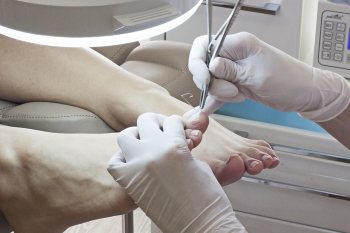
The procedure is largely therapeutic and can only be performed by a specialist with a medical education . During it, the master even treats infections, if any.
First, the feet are treated with an antiseptic, then softened with special means, and cleaned of keratinized growths. The nail plate is given the desired shape, the surface is sanded, treated with antibacterial substances and, if desired, varnished by the client. The feet are massaged with nourishing creams that tone the skin of the feet.
Liquid pedicure (fruit-acid)
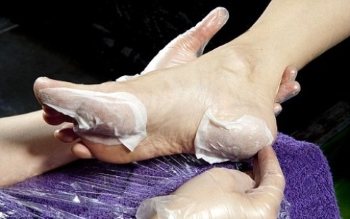
These treatments are performed using a chemical called liquid blade (commercially available) which helps soften skin tags and promote rapid regeneration. The product works only on rough skin, without touching healthy skin. Regular use of liquid pedicure will have a healing effect and completely relieve you of cracked heels . The procedure can be carried out both in the salon and at home.
The solution contains the following acids: glycolic, vegetable and fruit, lactic. Therefore, such a solution is easy to prepare even on your own. After the feet have been in the substance for 10-15 minutes, all exfoliated growths can be removed with a nail file or grater, treated with an antiseptic and lubricated with a nourishing cream.
Hardware pedicure

Hardware cosmetology has reached our feet, so we can bring them into ideal condition with the help of special cutters. They will carefully and without the risk of infection and injury remove all dead skin layers using different cutter attachments . Before the main procedure begins, the feet are treated with special softening agents. In this case, the removal of healthy skin is completely excluded, and the end result will surprise you with its duration.
Men's pedicure
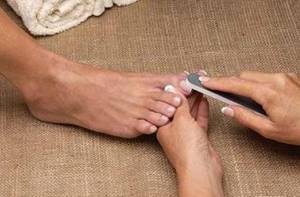
It is no different from women’s, so it can be performed in any of the above ways. The only difference is that men do not cover their nails with bright varnishes, but choose a transparent or simply protective base. For a master, a man's pedicure is a little more difficult than a woman's due to the increased size of the foot and rougher skin.
Children's pedicure

The procedure consists only of correctly cutting the nails with scissors with rounded ends. The main thing here is not to cause an infection and not to cut off the corners, so as not to get rid of the ingrown nail later. The best time for a children's pedicure is after a bath, when the nail plate is softer and more pliable. The salon can also use hardware pedicures for children.
European or unedged pedicure
The main difference between a European pedicure and a classic one is that it is done on dry feet. A special softening agent is applied to the cuticle and after 5-10 minutes it is carefully moved to the edges of the plate with an orange stick. To clean keratinized areas, special graters and scrapers are used. Using scissors and tweezers, the edges of the nail plate are formed.
This is a safe procedure, there is no risk of injury or infection, the cuticle is noticeably reduced. But the European pedicure has one drawback. This is a fairly delicate procedure and it may take more than 6 sessions to tidy up unkempt feet.
Hardware pedicure
Hardware pedicure is done using a special technique, the operating principle of which is based on the rotation of rough attachments - cutters. When they come into contact with the skin, they clean off dead cells, which are pre-dissolved with a special product. This prevents damage to living cells.
After removing dead cells, the tips are changed to safely and quickly:
- cuticle removal;
- formation of the nail plate;
- polishing the nail.
Since living tissues are not injured during manipulation, the risk of infection is reduced to zero, but the softness and tenderness of the legs remains after such a session much longer than when using other types of pedicure.
Combined approach
The most controversial reviews are found about the combined type of pedicure. It is a marketing ploy that allows the master to charge more for his work. This is the usual classic option, in which the skin is polished using a machine. It just makes the job easier for the craftsman. However, all the disadvantages of the classical method remain.
This type involves, like all other approaches, applying varnish to the nails (at the client’s request). However, nail extensions are a separate procedure that is not included in any pedicure. Types of coating vary in structure, color and possible therapeutic effect.
Acid pedicure
Acid peeling is a new procedure that can be used to restore the beauty of feet in salons and at home. With the help of glycolic acid, contained in large quantities in grapes, beet rhizomes and other plants, they get rid of rough layers of skin. You can treat your feet in this way in the salon and at home. This method is less damaging to tissue than other options.
During the session, glycolic acid is applied to the skin, and the feet are wrapped in film and a towel. The procedure lasts one and a half hours. After its completion, very rough areas are slightly treated with pumice. The mixture is washed off and the legs are lubricated with nourishing cream. The simple, accessible procedure has one drawback: within five days after it, the skin on the legs peels off in layers, it doesn’t look very nice, so you can’t do without socks.
SPA – pedicure
A very pleasant procedure, the technique of which is based on the use of various, usually natural, ingredients to care for the skin of the feet, soften and dissolve rough skin. This is not just a way to improve the appearance of your feet, but also a relaxing technique.
First, the legs are placed in an antiseptic bath or treated with a disinfectant composition. In some salons, this is followed by a hardware pedicure, but a true SPA procedure does not tolerate haste and mechanisms. Therefore, if the condition of the skin of the legs allows it, it is soft enough to avoid harsh effects, the master peels with sea salt. Then compositions with fruit acids are used, the skin is washed, and a nourishing mask is applied to it.
The session ends with a relaxing foot massage, which activates the entire body. During the massage, a moisturizing composition is applied to the legs, preventing the skin from drying out and cracking after the procedure.
The disadvantages include the excessive delicacy of the method. With very rough skin, if you do not use the device, it may take up to 10 sessions to get your feet in order. Although the pleasure of the procedure can compensate for all costs.
French pedicure
This is not so much a method of foot care as it is the design of nails in a certain style. As a hygienic procedure for caring for the skin of the feet, cuticles or nails, you can use any type of hygienic manicure: classic, European, hardware or any other. Depends on preference.
At home, they usually combine types of pedicure using steps from classic and European manicure. To clean the heels of rough skin, they are steamed in a bath and then treated with a special file or brush, but the cuticle is not cut off, but pushed back. Nails can be tidied up with scissors or clippers and a nail file. When the foot looks perfect, a decorative coating is applied: the pink nail ends with a white stripe.
A little history
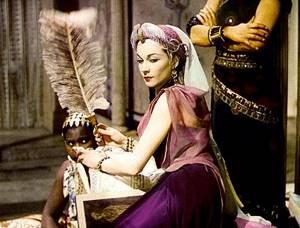
The birthplace of pedicure is Ancient Egypt. Noble Egyptians attached great importance to the condition of their feet, regularly softening them with various oils, massaging them, and monitoring the condition of their nails. The Egyptian queen Cleopatra had special servants whose duty was to daily rub the queen’s feet with aromatic oils, massage her toes, and then dry them with peacock feathers.
In Ancient Greece, there was also a whole range of foot care measures. In addition to cutting nails, aromatherapy was used on the skin of the feet. And a special luxury was painting the feet with organic dyes. At the same time, the Greeks believed that points responsible for the functioning of internal organs were concentrated in the feet. Modern acupuncture has confirmed this fact, and treatment using biologically active points on the foot is very popular.
In ancient China, only high-ranking officials were allowed to get pedicures. In addition to hygienic care, their nails were painted in bright colors, and the brighter the nails were painted, the higher their position in society.
In Europe, the first foot care specialists appeared in England. And the first pedicurist was David Lowe. In 1780, he decided to start cutting calluses, which was a very profitable business. And in 1785, David published a scientific work on the feet called Chiropodology. In this very work, the term “pedicure master” first appeared.
In 1830, an American physician, Dr. Zitts, first used metal instruments for the hygienic treatment of nails and surrounding skin. All this, of course, was done not for aesthetic reasons, but for the prevention of skin diseases and was called the “Sitts Method”. It was only in 1892 that it became available to all women and gained enormous popularity in the United States.
A scientific approach to pedicure has also become possible in the USA. In 1913 (according to other sources - in 1916) the first pedicure school opened in New York. At the same time, the real sensation was that one of the graduates was a woman. After all, until that moment, the profession of a pedicurist was considered purely masculine.

